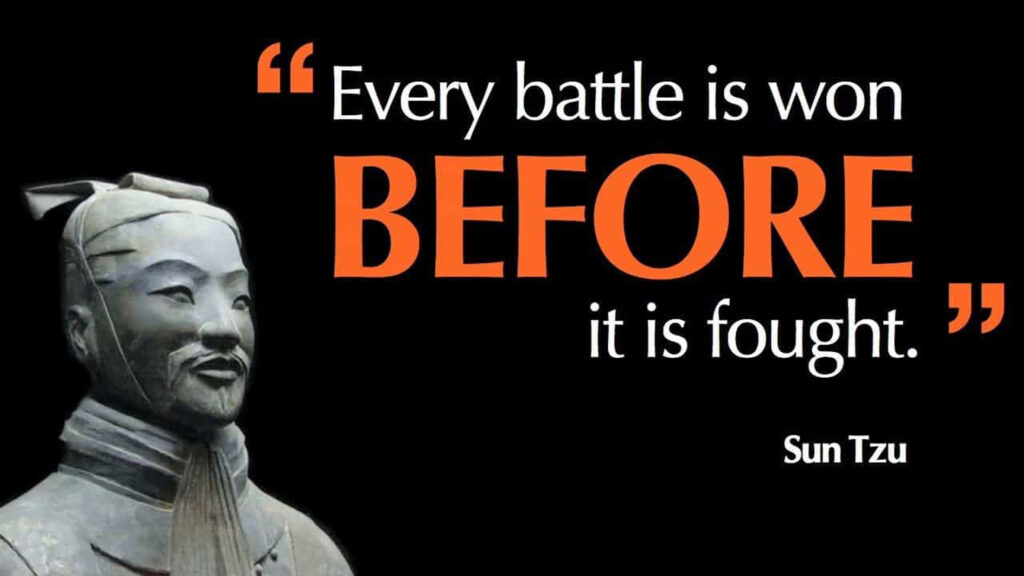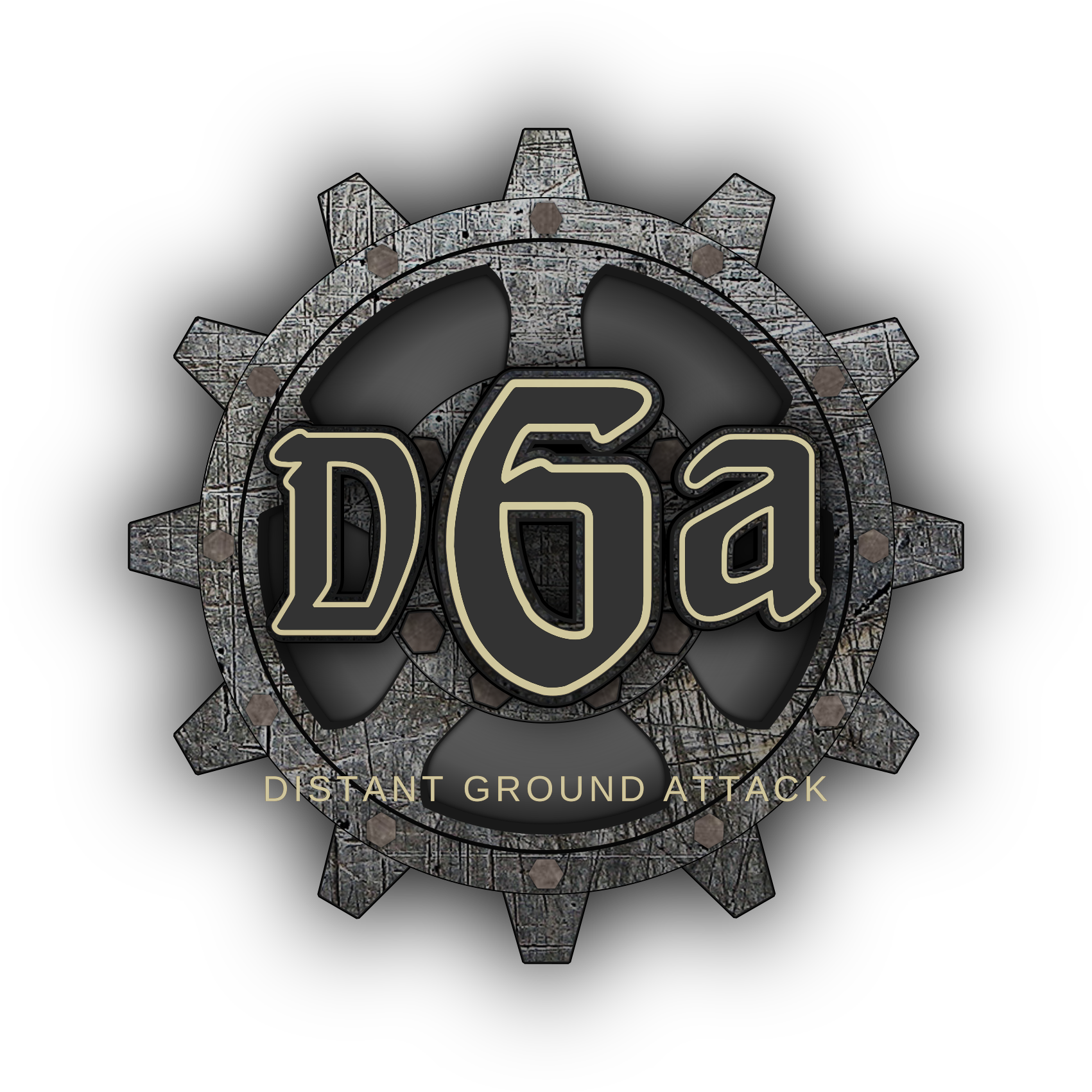2. Game Concept
|
This section is currently a draft, and is subject to change. |
DGA aims to introduce, engage, and immerse players into the art of war and warfare by featuring them with weapons. Master Sun — the longest existing and most widely studied military classic in human history — stated two and a half thousand years ago the canon of this art, which has remained a prominent force in the military arts until nowadays. (TAOWA, p. 9)
This chapter outlines the key gaming concepts of the DGA Game.
The art of war, then, is governed by five constant factors, to be taken into account in one’s deliberations, when seeking to determine the conditions obtaining in the field.
These are: (1) The Moral Law; (2) Heaven; (3) Earth; (4) The Commander; (5) Method and discipline.
The Moral Law causes the people to be in complete accord with their ruler, so that they will follow him regardless of their lives, undismayed by any danger.
Heaven signifies night and day, cold and heat, times and seasons.
Earth comprises distances, great and small; danger and security; open ground and narrow passes; the chances of life and death.
The Commander stands for the virtues of wisdom, sincerity, benevolence, courage and strictness.
By Method and discipline are to be understood the marshalling of the army in its proper subdivisions, the gradations of rank among the officers, the maintenance of roads by which supplies may reach the army, and the control of military expenditure.
These five heads should be familiar to every general: he who knows them will be victorious; he who knows them not will fail.
Therefore, in your deliberations, when seeking to determine the military conditions, let them be made the basis of a comparison, in this wise:
1. Which of the two sovereigns is imbued with the Moral Law?
2. Which of the two generals has most ability?
3. With whom lie the advantages derived from Heaven and Earth?
4. On which side is discipline most rigorously enforced?
5. Which army is the stronger?
6. On which side are officers and men more highly trained?
7. In which army is there the greater constancy both in reward and punishment?
By means of these seven considerations I can forecast victory or defeat.
The general that hearkens to my counsel and acts upon it, will conquer: — let such a one be retained in command! The general that hearkens not to my counsel nor acts upon it, will suffer defeat: — let such a one be dismissed!
While heeding the profit of my counsel, avail yourself also of any helpful circumstances over and beyond the ordinary rules.
According as circumstances are favourable, one should modify one’s plans.
All warfare is based on deception. (TAOWG, pp. 27-29)
The Art of War: Chapter I. Laying Plans (5th century BCE)

Figure 2.1. Master Sun
2.4. Game Concept Statement
DGA aims to turn a player into a commander taking control over a selected historical weapon unit, single or combined, which, as in the art of war, rigorously goes into a battle on a historic map of choice.
The player manages the unit’s position, movement, firing, and communications with allied players from the third/first-person view. Different types of weaponry can simultaneously participate in a single battle session, which may have limitations on time and amount of players. The first types of weapons being realised are mechanised/motorised land combat vehicles and guns, dating from the time of World War I up to the Cold War, with giving preference to World War II.
The player chooses a weapon unit between different types of weaponry. The choice is bound to the type’s limitations and player’s experience only. The player goes into battle with the chosen weapon in a team that can be composed randomly as well as by agreement. The goal is to put out of action all the units of the opposite team or to accomplish some victorious condition (capture the flag, maintain a position against enemies, make the opposite team surrender, etc.). The player’s progression depends only on how well he/she can utilise potential of the chosen weapon unit and coordinate his/her actions with other players in the team.
2.5. The One Question
DGA’s gameplay has the following One Question: (AGDS, p. 196)
Does it intelligent, sincere, humane, fair, and just?
Reliance on intelligence alone results in rebelliousness. Exercise of humaneness alone results in weakness. Fixation on trust results in folly. Dependence on the strength of courage results in violence. Excessive sternness of command results in cruelty. When one has all five virtues together, each appropriate to its function, then one can be a military leader. (TAOWC, pp. 49-50)
(Tang Dynasty 618–906 CE)
Intelligent as in wisdom.
Sincere as in trustworthiness.
Humane as in humaneness.
Fair as in fair play.
Just as in authenticity and accuracy.
2.6. Game Mood
Imperil yourself!
So it is said that if you know others and know yourself, you will not be imperiled in a hundred battles; if you do not know others but know yourself, you win one and lose one; if you do not know others and do not know yourself, you will be imperiled in every single battle. (TAOWC, p. 91)
The Art of War: Chapter III. Planning a Siege (5th century BCE)
When you know others, then you are able to attack them. When you know yourself, you are able to protect yourself. Attack is the time for defense, defense is a strategy of attack. If you know this, you will not be in danger even if you fight a hundred battles.
When you only know yourself, this means guarding your energy and waiting. This is why knowing defense but not offense means half victory and half defeat.
When you know neither the arts of defense nor the arts of attack, you will lose in battle. (TAOWC, pp. 91-92)
(Sung Dynasty 960–1278 CE)
2.7. Genres
DGA is a sophisticated, visually stunning, free/libre-to-game, cross-platform by design, massively multiplayer online role-playing game, which combines:
DGA is addressed to casual and core gamers. The game strives to provide players with a transparent, fair-to-play balance between historic authenticity and fast-paced shooter gameplay.
2.8. Target Audience
DGA aims to address casual and core gamers of all genders and ages who are already interested in the history of weapons, military history, and mechanics, but also those whose interest in these fields of knowledge could be piqued as well.
DGA is intended to meet all the gamers' areas of motivation and incentives as follows:
-
Action, assuming destruction and fast-paced, exciting gameplay.
-
Social, including both community and competition (which are not mutually exclusive).
-
Mastery, providing difficult challenges and long-term strategies.
-
Achievement, while completing all missions and becoming powerful.
-
Immersion, of being someone else and experiencing an elaborate story.
-
Creativity, expressing yourself via design, fantasy, crafting, and customisation, as well as tinkering and exploring. (AGDS, pp. 200-201)
DGA promises to avoid any depiction of blood, bodies, and other signs of war related to humans. However, the game contains depictions of non-realistic, non-detailed violence.
The desired ratings DGA aims to achieve are "PEGI’s 7 with the descriptor Violence" and "ESRB’s Everyone".


2.9. Target Platforms
DGA pursues the Cross-Platform by Design approach, which seeks bridging the gap between different devices and platforms. This approach is based on the idea to implement technologies designed to adapt and respond to different operating systems and screen sizes, ensuring that the user’s experience is consistent but also engaging and efficient, no matter the device in use. (Medium)
DGA is designed and developed on and for the Java Platform — the complete and full-scaled cross-platform technology implemented on a wide variety of computing platforms from embedded devices and mobile phones to enterprise servers and supercomputers.
DGA targets all platforms where Java is working on:
-
Primarily the PC market with its, first of all, free/libre/open-source operating systems (GNU/Linux, BSD, HarmonyOS) and closed-source proprietary ones (Microsoft Windows, macOS);
-
Then mobile platforms with their free/libre/open-source operating systems (Android, HarmonyOS) and closed-source proprietary ones (iOS, iPadOS);
-
Then the game console market (Sony PlayStation, Microsoft Xbox, Nintendo Switch).
2.10. Game Flow
While playing the DGA Game, a player becomes a commander taking control over a selected historical weapon unit and goes into a battle on a historic map of choice.
DGA implements the fair-to-play principle in the field of computer games modeling historical weapons and asserts that such a weapon must be modeled in the game authentically, correctly, and without being changed for any reason other than adjustments in favor of historical accuracy.
DGA treats as unfair and inappropriate the practice of some modern warfare-themed games in which weapon units are presented as modeled to closely resemble their real-life counterparts, but several their parameters can be simplified or modified to fit game mechanics and better gameplay. This practice leads to everlasting uppings and nerfings of the weapon units, which historical accuracy afterwards players can’t even estimate. Moreover, the owners of some games systematically exploit historical accuracy and authenticity to compensate game bugs, misinformation, bad balance, and declining revenues from users. Finally, it ends in disrespect and injustice to players.
The closed-source proprietary nature of computer games is the real cause of this regrettable situation in gaming. The games' owners are in the position of power over their players and once too often do not hesitate this power to misuse. For this reason, DGA is free/libre-to-game.
DGA additionally affirms that parameters of historical weapons must be hard-coded in the game. Eventually, the modeled weapons are historical and their parameters usually are well-known, described in multiple sources, and can’t be changed due to their historical nature. The only reason why the weapons in the game can be remodeled is to improve their historical accuracy.
Striving to find a fair-to-play balance between historical accuracy, authenticity, and fast-paced shooter gameplay, DGA addresses distinct categories of players and implements the following three battle modes, which establish different proportions between accuracy/authenticity and shooting gameplay:
-
Struggle Battle Mode (the most fast-paced and accurately authentic).
-
Realistic Battle Mode (reasonably fast-paced and accurately authentic).
-
Simulator Battle Mode (the most authentic and reasonably fast-paced).
DGA is conceived to feature players with an open-ended, unlimited experience in modification and customisation of the game’s weapons and characters strictly according to their historical authenticity and accuracy. DGA aims to support not only production modifications and customisations but also field ones made by soldiers and service crews on the front line.
2.11. Look and Feel
DGA is a third-person shooter with a facility to switch the camera perspective to a first-person view of the weapon unit’s commander and other crew members.
Consequently, DGA features the following camera perspectives:
-
The weapon unit’s third-person perspective.
-
The weapon unit’s targeted (first-person) perspective.
-
The crew-member’s third-person perspective.
-
The crew-member’s targeted (first-person) perspective.
DGA’s pacing, visuals, and level of action aim to be at the same level with the best of action warfare-themed shooters.
2.12. Game Balance
DGA has a complex game balance. It is arisen out of the following factors:
-
Historical authenticity and accuracy require that the weapons modeled in the game strictly match their historical counterparts, which had different parameters and properties.
-
Open-ended modifications and customisations of weapons and characters produce combinatorial growth, which provides many benefits but makes difficult to test every possible combination of character, weapon, and environment in every possible moment of play.
-
The fair-to-play principle stipulates that the best and most skilful player wins the battle. All other causes must be neglected in a fair battle.
Considering the factors above, DGA combines transitive and intransitive approaches to its balance.
2.13. Game Security
DGA is free/libre-to-game for its players whose security and confidentiality is assured by the game. However, there is an open discourse whether it is possible to secure a free/libre/open-source MMORPG, which source code is accessible to cheating and bullying players.
DGA relies on Kerckhoffs’s principle, which states that a free/libre/open-source program is not inherently less secure than a proprietary or commercial one, but it is no more secure either.
2.14. Anti-Cheating Statement
DGA is fully committed to anti-cheating policies and measures to ensure fairness, equality, justice, honesty, and integrity to all its players. Cheating by the players not only threaten other players but also violates the fair-to-play principle.
At the same time, the DGA Game and The FLEISS Software Foundation do not consider cheating as the immanent nature of MMO games and their players. Inherently unfair players constitute an insignificant part of gaming community consisting of people who sincerely and honestly share their love for playing video games.
2.15. Unique Selling Points
While building on the tried-and-true third/first-person action warfare-themed shooter gameplay, DGA innovates in a number of key areas:
-
Free/Libre-To-Game: DGA implements a free/libre/open-source, fair-to-play approach, which produces a fully transparent, trustworthy, respectful to all concerned parties business, development, and social ecosystem.
-
Community-Driven Development: DGA aims to form an active, vibrant, globally distributed community of people interested in gaming, military history, mechanics, game design, game development, 3D design, etc.
-
Historical Authenticity/Accuracy: DGA is intended to become a tool for transparent reconstruction of historical weapons — discuss and modeling them, trying them out, test and prove, compare and oppose them.
-
Cross-Platform By Design: DGA strives to be built on the most free/libre/open-source, cross-platform, powerful technologies ensuring the possibility to avoid vendor and platform lock-ins.
-
Unlimited Game Design: DGA gives players open-ended control over their environments, characters, weapons, as well as in the creation of their own modifications and customisations. The only limit is historical authenticity and accuracy. On the other hand, game designers and developers, as well as any volunteer can freely create derived works to be added into the game or used independently.
-
Massively Multiplayer Online: DGA allows players to participate in battles, install new game servers and domains, create new modes and features.
-
World Domination Story: DGA has no limits in growth, diffusion, and dissemination.
Want to help? Learn how to contribute to FLEISSF DGA Docs



